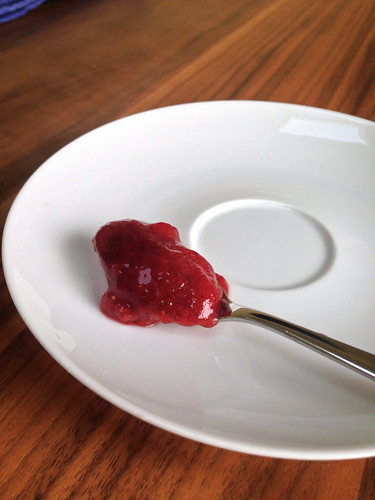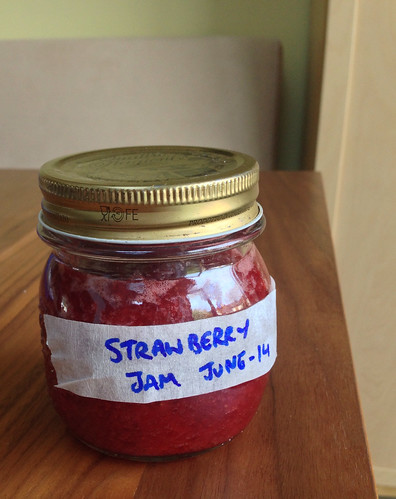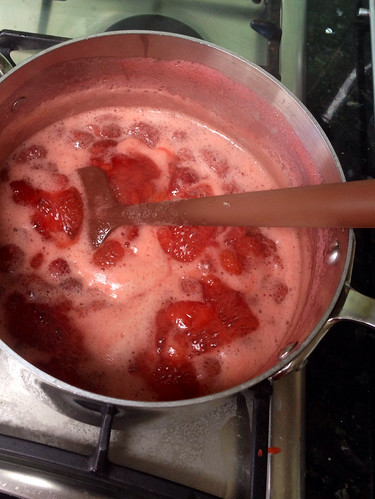I have a very neglected strawberry patch. When we first changed our garden to create space to plant vegetables, I planted five Cambridge Favourite strawberry plants along with the lettuces and tomatoes. Since then, I have been very inattentive and have let them multiply all over the place until they take up a good third of the growing area. This year, because of pregnancy and baby, I have been particularly neglectful, but despite that, and the efforts of some greedy local wood pigeons, there has been a bumper crop.
I put the first batch into roasted strawberry syrup and strawberry frozen yoghurt, following Jennie’s recipes. Then as another batch started to look neglected in the fridge, I knew the only way to hang onto their fragrance and flavour was jam.
Strawberry jam has a particularly tricky reputation. This is because strawberries contain very little pectin, the sticky substance that makes jams thicken, and so need lots of encouragement to set. It’s easy to end up with strawberry soup, which slides and drips off scones and toast. To combat this tendency, recipes typically include lemon juice, lots of sugar and added pectin, either from a bottle or using jam sugar.
I wanted a fresh tasting jam, without excessive boiling, and something I could do quickly (babies require you to shorten all tasks as much as possible). Many recipes ask you to macerate the fruit and sugar overnight, so they were out. I decided on Kim Boyce’s recipe in ‘Good to the Grain‘. This one is unusual in a few ways. First, it asks you to cook the sugar with water into a syrup before adding the fruit. My guess is that this allows you to cook the berries for a shorter time. It also contains much less sugar than other recipes: a cup for 3 lbs of fruit (or 230g sugar to 1.3kg fruit).
I liked the idea of this recipe, but was a bit scared that it would produce a soup, so I made the following changes:
– although I had only 900g (2lbs) fruit, I kept the sugar quantity the same
– I added the juice of half a lemon
– I then chopped the rest of the lemon half into slices and boiled it in water with the pips for 10 minutes. I then strained this into the pan with the berries.
This is a quick way to extract some pectin, and if you have more time, can be done more thoroughly, with the pieces squeezed through muslin (see marmalade post). This is loosely adapted from a June Taylor method, and a Christine Ferber recipe. As well as helping the set, I find adding lemon to strawberry jam really lifts the flavour, and prevents it from being cloying. (Felicity Cloake agrees).
[to see how effective this approach can be, when you have a lot of lemon pips, put them in a bowl and cover with cold water, and leave them to stand. The water will likely gel as the pectin coating the pips dissolves in the water.]
After boiling for 15-20 minutes, the mixture reduced down to a thick bright-red syrup, and after testing for a set, I took it off the heat. I then added a final lemon flourish by zesting the remaining lemon half straight into the jam before putting into jars.
This does not produce a remotely stiff jelly, and is a decidedly spoonable consistency that needs to be kept in the fridge. But the bright colour and flavour are enough to convince me to try this approach again when strawberries come around next year.
Recipe: Soft set strawberry jam
adapted from Kim Boyce ‘Good to the Grain’, an inspiring book of recipes for unconventional flours and grains
- 900g strawberries
- 240g sugar
- A lemon
Wash and hull the strawberries. Cut most of them in half, leaving the tiny thumbnail sized ones whole, and cutting the big monsters into quarters. The berries will break down as they cook, so the pieces don’t need to be small.
Halve the lemon, juice one half and reserve, and slice the empty half into thin pieces. Put into a small saucepan with any pips, cover with cold water and boil for about 10 mins to extract the pectin.
Put a couple of saucers or small plates in the freezer to check the set later on.
Place the sugar into a large saucepan or preserving pan and add about 100ml water. This is the pan you will make the jam in, so it needs enough room to allow the jam to bubble up (minimum of 4 litre capacity). Put on a medium-high heat and bring to the boil to dissolve the sugar. Swirl the pan occasionally to ensure the sugar crystals all dissolve, and to make sure there are no hotspots where the sugar could start to caramelise.
Once the syrup is clear and bubbling, add the strawberries, lemon juice, and strain in the water from the lemon half, pressing down on the solids. If you have time, you can cool these pieces and put into muslin and squeeze it to extract even more pectin.
Bring everything to a rapid boil, turning the temperature down if it threatens to boil over. Stir occasionally to make sure nothing is sticking to the bottom. The mixture should reduce down and thicken. When it seems thick, take out a spoonful onto one of the cold saucers or plates. Leave it in the fridge for a minute or two, and take the pan off the heat. When you push the side of the blob of jam with a finger, you should be able to see wrinkles on the surface, which indicate a set. Mine reached 102.5C with a thermometer when I took it off the heat (usually you look for 104C for jam to set, but as this has little sugar, and sets softly, it won’t get there).
With the jam off the heat, zest in the remaining lemon half and stir in. Allow the jam to settle and thicken a little in the pan before putting into clean, sterilised jam jars. As this has so little sugar, it should be kept in the fridge.





Did you know you can chop in a kiwi to add pectin too? It was a tip I discovered from the NY times last year, and it works like a charm. You don’t taste the kiwi, but the jam has a beautiful soft set.
Sounds like a great tip, and I bet the acidity would work well with the strawberries too. Do you have the link to the NY Times article?
Here you go. I found the boil was a lot less than that recommended in the article — maybe 20 minutes rather than 40. It was possibly the best strawberry jam I’ve ever made.
http://www.nytimes.com/recipes/1014783/strawberry-jam-with-kiwi.html
[…] have a bit of jam fetish. At the present moment, my fridge contains homemade strawberry jam, marmalade and lemon curd, as well as bought apricot and lingonberry jams. In the cupboard is more […]